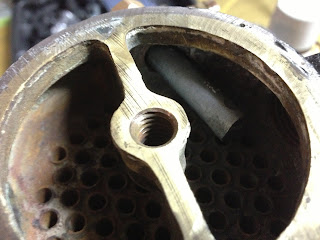We were finally away and our heading was to places we had not been to before. This was part two of our summer on Corleto. As we slipped away from the dock at Horseshoe Bay, there was a certain relief that we had managed to pack everything without too much fuss.
As it was after 6 and with a prawn trap to collect as we departed, it occurred to Charlene that daylight would be fading soon. After hauling two dozen prawns we at least knew that our meal when we got to our anchorage would be fresh seafood.
With Charlene at the helm and me at the anchor locker on the bow, we arrived and set our Danforth with little fanfare. Both of us now ready for a taste of our catch, relieved that we managed to get to Plumper Cove before dark.
After our late supper, we decided to take a swim around midnight. It was the first time I experienced "luminescence" in the water. Stars seemed to shoot out of my fingertips, my arms and my legs. That was pretty neat. All in all, we were off to a good start to sailing adventure part II.
 |
| Charlene doing some Yoga before setting out from Plumper Cove |
The second leg of the journey however was to have its challenges. The weather had decidedly cooled. The South East wind was now 20- 25 knots, but since we were traveling north, we would have the wind and waves to our back. I decided that we would motor as Charlene was having some difficulty getting her sea legs.
 |
| Another Yoga position- Downward Facing Sea Dog |
With a following sea and a strong tail wind, the boat surfing along. Corleto was managing a pretty constant speed of 6 knots. Charlene by now had retired to her "recovery" position on deck as I manned the helm. Gotta say there were a hell of a lot of caps, I just hoped that wherever we were to drop the hook, it would be protected enough to allow Charlene to recover.
 |
| Trying to keep a steady helm |
 |
| The calm of Smuggler's Cove |
Stern Tying is an anchoring technique I had never attempted before. I studied how the other boats were fastened to the shore and the position of their respective anchor lines. I noticed all of the boats had a yellow "floating" line as the material of choice for this method.
All I had was my prawn fishing line, it was 400 ft, but it did not float. So I went scurried to shore and ran the line that I had, through the eyelet and then back to the boat. Funny thing about an anchorage, everybody's watching you, silently judging and critiquing your anchoring skill or in my case LACK THERE OF.
There was lady whom was out for a row around the cove. She was a crewmember of a lovely 35 footer from Seattle. She came by and struck up a conversation with Charlene. She said " It looks like you got it right" and so with that endorsement, my confidence was high with our anchor set up. I went to bed later that evening feeling good about what we had accomplished with a method that was totally foreign to me.
It was shortly before zero dark 3 am when THUD. I woke up like a shot. Charlene awoke too.
I noticed that there was a tree just off the port quarter about 15 feet away.
"We have bottomed out!" I said "Get me my life jacket" and I immediately started the engine.
I quickly checked my trusty "AYE TIDES" app to see what the tide was doing. It was falling and the low tide was not for another 2 hours. I know that we need to do something and fast. The wind is now coming up and with the pitch black, I am surprised just how calm we both are. No yelling, just urgency.
Charlene returned like a shot with my life jacket. She had her's on as well. I went overboard to the dingy to survey the situation.
Charlene reports "Murray, I cannot move the tiller"
"OK don't force it we don't want to damage the rudder." I reply.
I get myself and the dingy wedged between Corleto and the rock. Then there is a bit of a surge.
Charlene reports "The tiller is free."
After hearing her report, I jumped on, grabed the tiller, put the engine in gear and hit the throttle.
And just like that we are floating and Corleto glides away from the rocky shore. A wave of relief come over the ol' Skipper as I handed the helm to Charlene. I quickly tossed the stern lines overboard and then scampered to the bow to attend the anchor.
We reset the main anchor in the middle of the cove. We are able to swing with the wind and are far enough away from the other boats that our swing radius will not present any collision issues with any of the others.
Charlene stops the engine. We look at each other and then embrace with a reassuring hug.
"We're ok, the boat's OK. "
Needless to say neither one of us slept for the rest of the night.
Daybreak was a welcome sight.
 |
| Where it went THUMP in the night. This shot taken the next day after we went to Secret Cove to get some floating stern line. |
I did snorkel under Corleto's keel and rudder to find no damage. She may be old but she took care of her crew while teaching a valuable lesson.
She's a good boat.















